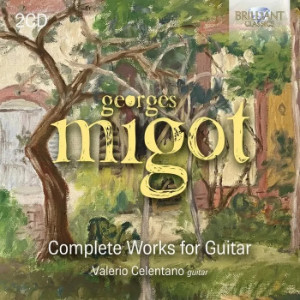
Georges Migot (1891–1976)
Complete Works for Guitar
Valerio Celentano (guitar)
Franco Ascolese (flute) Nicola Montella (guitar), Rinako Hara (soprano)
rec. 2022/23, Trieste and Salerno, Italy
Brilliant Classics 96848 [2 CDs: 97]
Highly regarded by Florent Schmitt, Parisian composer, poet and painter Georges Migot wrote a lot of music. A student at the Paris Conservatory, he attended the classes of Gedalge, Widor, Guilmant, Vierne, d’Indy and Emmanuel. Unusually for a composer of the last century, he held Couperin and Rameau in the highest and most inspiring regard. He was seriously wounded in the Great War after which he twice missed out on the much coveted Prix de Rome. He was on the teaching staff of the Schola Cantorum and, like Henri Tomasi, did sterling work for French radio. His catalogue includes five operas (1922-1971), including L’Arche, a “spatial polyphony” for soprano, women’s chorus and orchestra, 14 symphonies (1919-1971), many other orchestral works, including Zodiaque (also in a version for solo piano), two Dialogues for solo instruments and orchestra (1924-27), La Jongle, for organ and orchestra (1928), a Piano Concerto (1962) and, over a long and productive life, a significant number of chamber pieces.
A three-section work, Pour un Hommage à Claude Debussy (1924) was dedicated to Segovia. It is heard here in a version prepared by Valerio Celentano from the original manuscript. It’s ornate, virtuosic and direct-speaking. Strangely, it is reminiscent of Ravel rather than Debussy but then again it is a homage rather than a pastiche. Contentment is the pervasive mood. The four-movement Sonate pour guitare is satisfying and stately without being sedate. The finale is no make-weight; a variety of moods is fused by an overarching concentration that picks up on the three preceding movements. Migot’s last work for guitar, The Trois Chansons de joye et de souci (1969) for soprano and guitar traces its lineage to the composer’s Six Poèmes (Pierre Moussarie) for voice and piano. These are lustrous settings where the guitar part, for all its occasional complexity, bears up the delectable soprano voice of Rinako Hara without getting in the way of word formation. It’s a shame that the texts are not provided in the booklet. The music is a vehicle for rapture and Hara’s largely vibrato-less voice complements Migot’s words.
The Two Preludes (1961) for two guitars are dedicated to the (to me) unknown, Argentinian Duo Pomponio-Zarate. These are again sultry and intricately contrived carriers for subtly shaded moods. A year later Migot completed his Sonate pour deux guitares. For this Celentano is joined, as he was in the preludes, by the equally dextrous Nicola Montella. The four substantial and extended movements of this sonata are unhurried and self-absorbed yet speak eloquently to the listener. The Sonate pour flûte et guitare is dedicated to guitarist Turíbio Santos whose reputation extended well beyond his native Brazil; while not recorded as often as Bream and Williams, Santos established a resilient concert profile. The Sonate is in three movements. It is stimulating to hear the guitar in duet with Franco Ascolese’s flute. The two instruments bask in sunlight and shadow and in the work’s conclusion are wrapped in warmth.
The sound is closely recorded, catching a Fauré-like lambency and warmth that avoids any sense of suffocating analysis.
The booklet that comes with the set is in English and is by the soloist.
Rob Barnett
Help us financially by purchasing from



Contents
CD 1
1-3 Pour un hommage à Claude Debussy: Prélude 2; II. Pastorale; III. Postlude
4-7 Sonate pour guitare: I. Prélude; II. Allant; III. Andante grave 7; IV. Final
9-11 Trois chansons de joye et de souci de Pierre Moussarie: I. Chanson à danser; II. Chanson à retenir; III. Ronde
CD 2
1-2 Préludes pour deux guitares: I. Sur le nom de Graciela Pomponio; II. Sur le nom de Jorge Martínez Zárate
3-6 Sonate à deux guitares: I. Prélude; II. Comme une danse à deux; III. Andante; IV. Final
7-9 Sonate pour flûte et guitare: I. Prélude; II. Grave 9; III. Conclusion

















